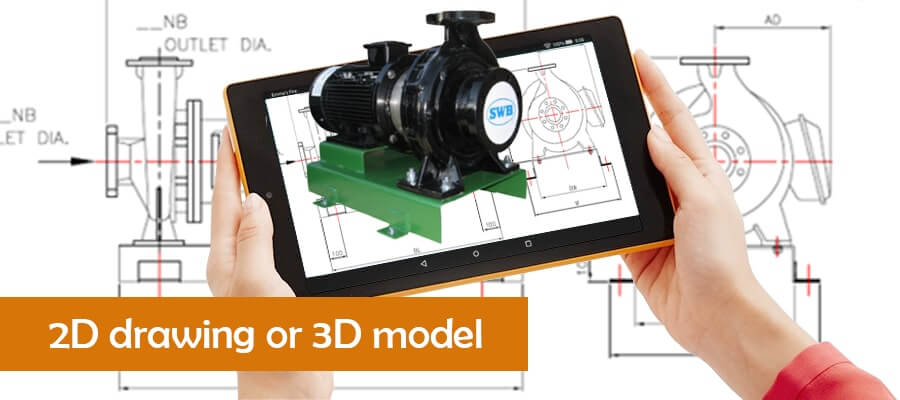
Choosing between 2D drawings and 3D models is crucial for metal fabricators. 3D models provide enhanced visualization, reducing errors and improving fabrication accuracy. They facilitate better collaboration and communication among stakeholders, leading to faster project completion and increased efficiency. Ultimately, opting for 3D modeling can enhance productivity and profitability.
Table of Contents
In the world of metal fabrication, precision isn’t just a competitive advantage – it’s essential for avoiding production delays, costly rework, and material wastage. Every design decision made during the planning stage directly impacts the efficiency of the fabrication processes. Whether a project involves CNC machining, laser cutting, or complex multi-material assemblies, choosing the right design format—either 2D drawings or 3D models—can make or break the outcome.
2D drawings offer simplicity and speed and are ideal for straightforward layouts and flat patterns. However, 3D models excel at providing detailed, multi-angle views, ensuring that every component fits together without alignment issues. The metal fabrication industry increasingly needs to strike a balance between the two formats, particularly for projects involving both cutting operations and intricate assemblies. This article aims to help metal fabricators make informed decisions, ensuring both efficiency and accuracy throughout the production process.
| Point | Description |
|---|---|
| Visualization | 3D CAD enhances design clarity and communication. |
| Precision | 3D models provide exact measurements, minimizing errors. |
| Collaboration | 3D formats improve teamwork among all project stakeholders. |
| Simulation | 3D CAD allows for virtual testing to spot design flaws. |
| Efficiency | 2D is quicker for simple tasks; 3D streamlines complex projects. |
A 2D CAD drawing is a flat representation of a part or assembly typically used for simple cutting operations and schematics. It includes dimensions, tolerances and annotations that indicate how a metal piece should be fabricated. AutoCAD, Inventor, and SolidWorks are popular tools for creating 2D drawings. These drawings are also exported in formats like DXF or DWG, which are widely used by CNC cutting machines.
Applications:
A 3D CAD model is a comprehensive digital representation of a product, showing it from every angle. Unlike 2D drawings, 3D models display height, width and depth, making it easier to understand complex geometries. SolidWorks, Autodesk Inventor, and Fusion 360 are commonly used to generate these models.
3D CAD files allow fabricators to manage complex assemblies and ensure every component fits together precisely. These models also help engineers include material properties, such as thickness, weight and tensile strength—factors crucial in metalworking.
Applications:
The choice between 2D drawings and 3D models depends on the specific needs of the fabrication project. 2D drawings are often the preferred option for cutting paths and simple parts, as they are faster to generate and are directly compatible with CNC machines. In contrast, 3D CAD models offer more detailed representations, making them ideal for assembling complex products, tracking material properties, and generating exploded views for easy assembly.
3D models provide a more holistic view, eliminating ambiguity, which is critical for multipart assemblies or products with intricate geometries. However, they can be expensive to produce and require advanced software tools and training. For metal fabricators, a hybrid approach—using 2D CAD for cutting operations and 3D models for assembly verification—often delivers the best results. This combination ensures both speed and precision, minimizing the risk of design-related errors during production.
| Point | Description |
|---|---|
| Clarity | 3D models offer better visualization, reducing misinterpretations. |
| Accuracy | 3D provides precise dimensions, minimizing fabrication errors. |
| Workflow | 3D models streamline collaboration and communication among teams. |
| Flexibility | 3D allows for easy modifications, adapting to design changes efficiently. |
| Cost-Effectiveness | 3D reduces rework and material waste, leading to long-term savings. |
Benefits:
Drawbacks:
Benefits:
Drawbacks:
2D CAD drawings are ideal when fabricators need quick and accurate files for laser cutting, waterjet cutting, or sheet metal bending. Their simplicity makes them suitable for weldment plans, brackets and electrical layouts, where depth and visualization are not essential. In contrast, 3D models shine in complex, multi-component structures such as metal staircases, railings or frames used in building products. They also allow fabricators to explore different material combinations and provide a clearer understanding of how each part fits into the final product.
A key benefit of using 3D models is the ability to identify potential issues early, such as misalignments or clearance problems, before production begins. Projects involving digital twins (virtual replicas for monitoring and maintenance) also benefit from 3D models, as they streamline tracking and version control over time. Choosing the right format for each task within a project ensures better outcomes and prevents unnecessary rework.
Success Story: 3D CAD Modeling Enabled Developing 1,500+ drawings/month
A Russian manufacturer of large structures contacted Hitech CADD Services to create 3D models, assembly and part drawings. The team received input files, including 2D PDF drawings and a PDF BOM, from which they developed estimation sheets and quotes for client approval. Using their expertise in weld structure modeling, they created 3D part models in SolidWorks and finalized steel structure assemblies, ensuring timely resolution of discrepancies before submitting verified assemblies via secure Dropbox.
The deliverables provided significant benefits to the client, including
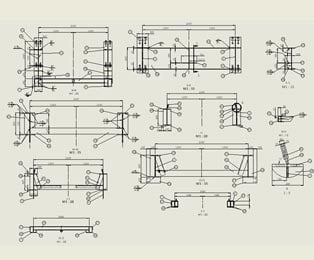 Assembly Drawing in SolidWorks
Assembly Drawing in SolidWorks
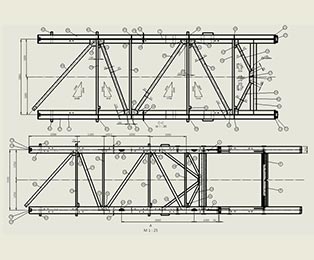 Part Drawing in DriveWorks
Part Drawing in DriveWorks
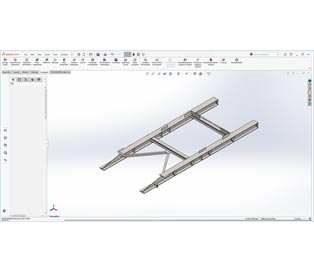 SolidWorks 3D Model of Steel Structure
SolidWorks 3D Model of Steel Structure
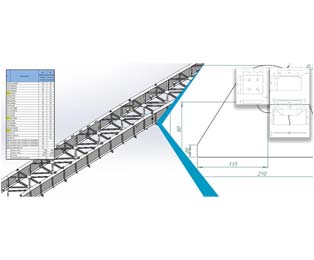 Estimation Sheet & 3D Model
Estimation Sheet & 3D Model
To fully unlock the potential of CAD tools in metal fabrication, fabricators must strategically combine the strengths of both 2D and 3D formats. This balanced approach allows them to meet project-specific demands efficiently. 2D drawings excel in tasks like generating precise cutting paths and flat layouts for laser and waterjet cutting. On the other hand, 3D CAD models are indispensable for ensuring proper fit during complex assembly processes and for enabling clear communication across teams working on intricate designs.
By blending these tools, teams can reduce lead times, limit production errors, and avoid redundant revisions. Following Design for Manufacturability (DFM) guidelines ensures that each design is optimized for the fabrication process, taking into account material limitations and machine capabilities. The adoption of cloud-based CAD platforms helps streamline collaboration, ensuring every stakeholder has access to the latest designs, whether in 2D or 3D format. Furthermore, adherence to ASME Y14.5 standards guarantees that dimensions and tolerances remain accurate across both drawing types, minimizing miscommunication and enhancing workflow efficiency.
This dual-format strategy ensures that fabricators have the flexibility to tackle a wide range of projects, from straightforward profiles to intricate assemblies, improving overall productivity while controlling costs and reducing waste.
Many fabricators adopt a hybrid approach, leveraging both 2D and 3D CAD tools. 2D drawings are used for cutting paths and welding layouts, while 3D models help with complex assemblies. This approach ensures both speed and accuracy, reducing errors and improving productivity.
Success Story: CAD drafting for sheet metal products as per DFMA guidelines reduces TAT by 56%
A US-based sheet metal fabricator contacted Hitech CADD Services for 3D CAD models, assembly drawings, and CAD files based on PDF drawings or hand-drawn sketches. Initial calls addressed tooling queries and RFIs. After training with the client, the team corrected design details in SolidWorks, created 3D parametric models, maintained work logs, and built a product library, delivering final drawings via secure email.
The deliverables provided significant benefits:
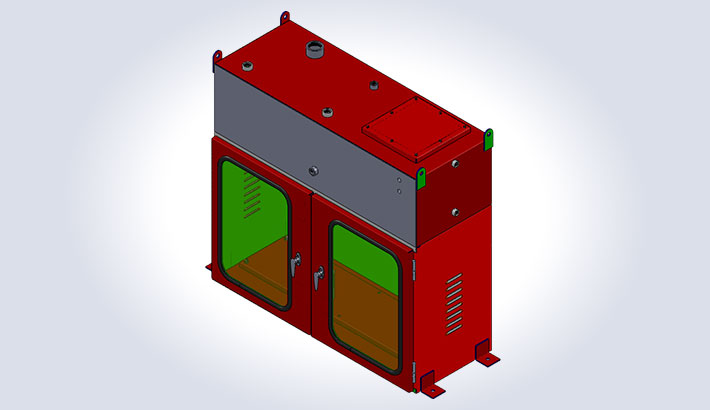 Enclosure with Tank
Enclosure with Tank
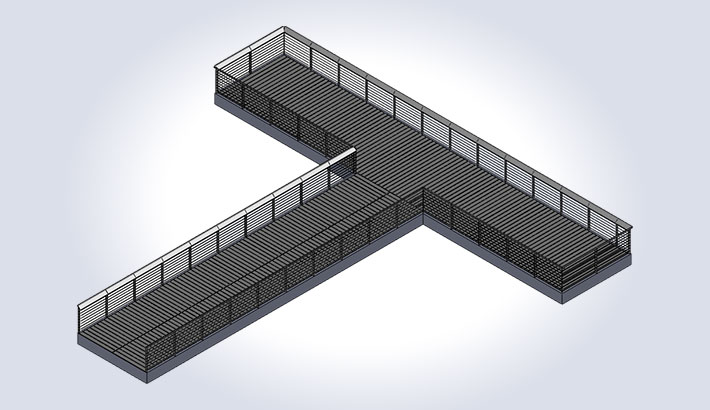 Pier Railing for Park
Pier Railing for Park
Selecting the right CAD format—2D or 3D—plays a crucial role in ensuring a smooth fabrication process. 2D drawings remain essential for quick, cost-effective layouts and CNC programming, while 3D models provide the depth and precision needed for complex assemblies. By adopting a hybrid approach, metal fabricators can leverage the best of both formats, ensuring accuracy and reducing production lead times. Implementing DFM principles and using cloud-based collaboration tools will further streamline workflows, helping fabricators avoid costly mistakes and optimize performance.
Yes, 2D CAD files in formats like DXF or DWG are sufficient for CNC operations, especially for laser cutting, plasma cutting, and bending profiles.
The cost varies based on the software used, licensing fees, and training requirements. Premium 3D CAD tools like SolidWorks or Inventor may have higher upfront costs but offer greater long-term value.
Design for Manufacturability (DFM) ensures that designs are optimized for efficient fabrication, reducing material waste, production costs, and the likelihood of errors.
Yes, 3D CAD tools streamline the prototyping and assembly processes, minimizing errors and the need for multiple design iterations, thus reducing lead times.
Using cloud-based platforms ensures easy access to updated files and improves version control, preventing errors caused by outdated or conflicting CAD files.
2D CAD tools tend to have lower licensing costs, while 3D CAD tools are more expensive due to their advanced features, higher computing requirements, and training needs.
You may also like
From 2D to 3D: Why Architects are Switching to BIM Modeling
10 Essential Best Practices for BIM in MEP Engineering
How 3D Scan to Revit Can Solve As-Built Modeling Challenges